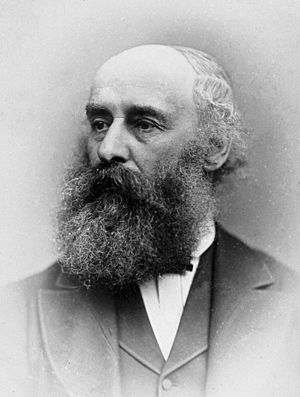John Syer Bristowe facts for kids
John Syer Bristowe (1827–1895) was an important English doctor, known for his work with diseases of the nervous system. He was also a great teacher and wrote many medical books.
Contents
His Life and Education
John Syer Bristowe was born in Camberwell on January 19, 1827. His father, also named John Syer Bristowe, was a doctor too. John went to Enfield School and King's College School.
In 1846, he started studying medicine at St Thomas' Hospital. He was a very good student and won many awards. In 1848, he won a special gold medal from the hospital. He also won a gold medal for studying botany, which is the study of plants.
Becoming a Doctor
By 1849, John became a member of the Royal College of Surgeons of England. This meant he was qualified to perform surgeries. He also got a special license to practice medicine. In 1850, he earned his first medical degree (MB) from the University of London. He won more awards for his studies in surgery, anatomy, and how medicines work. In 1852, he earned his advanced medical degree (MD) from the same university.
Working at St Thomas' Hospital
After finishing his studies, John worked at St Thomas' Hospital. He started as a house surgeon in 1849. The next year, he became the person in charge of the museum and studied diseases for the hospital.
Over the years, he took on many teaching roles. He taught about plants, medicines, and how the human body works. In 1860, he became a full physician, which is a senior doctor. From 1876 until he retired in 1892, he taught medicine. After retiring, he became a special consultant doctor for the hospital.
Other Important Roles
John Bristowe was also very active in the Royal College of Physicians. This is a very old and respected group of doctors. He became a fellow in 1858, which is a high honor. He helped examine other doctors and gave important lectures about diseases and how to treat them.
He also examined doctors for other universities and medical groups. For many years, he was the medical officer for public health in Camberwell. He also worked as a doctor for an insurance company and Westminster School.
In 1881, he was chosen to be a Fellow of the Royal Society. This is a very special group for top scientists. In 1884, he received an honorary law degree from the University of Edinburgh. He was also the president of several important medical societies, like the Pathological Society of London and the Neurological Society.
John Bristowe passed away on August 20, 1895, in Monmouth. He was buried at Norwood cemetery.
His Legacy and Contributions
John Bristowe was known as an excellent teacher, especially for students learning medicine at the hospital bedside. He was also very good at diagnosing and treating problems with the nervous system.
Important Reports
He wrote several important reports for the public health department. These included:
- A report on Phosphorus Poisoning in Match Manufacture (1862). In this report, he was the first to describe a serious jaw disease called "phossy jaw," which affected workers in match factories.
- A report on Infection by Rags and Paper Works (1865).
- A report on The Cattle Plague (1866), which he wrote with another doctor, John Burdon Sanderson.
- A very long report on The Hospitals of the United Kingdom (1863), written with Timothy Holmes.
Many of the detailed drawings in his books, especially those showing tiny things seen under a microscope, were drawn by him. His drawings of trichina spiralis, a tiny worm that can live in human muscles, were copied in many other medical textbooks.
Published Books
Bristowe also published several books:
- Poems (1850). He also released another book of poems later in his life.
- A Treatise on the Theory and Practice of Medicine (1876). This book became one of the most important textbooks for medical students and doctors in English-speaking countries. It was updated many times, with the 7th edition coming out in 1890.
- Clinical Lectures and Essays on Diseases of the Nervous System (1888).
- Annual Reports of the Medical Officer of Health to the Vestry of St. Giles, Camberwell, Surrey (1857–82).
He also helped edit the St. Thomas's Hospital Reports from 1870 to 1876.
When he retired from St Thomas' Hospital in 1892, money was collected to create a special medal. This medal is still given out to students who are very good at studying diseases.
His Family
On October 9, 1856, John Bristowe married Miriam Isabelle Stearns. They had five daughters and five sons together. His brother, Thomas Lynn Bristowe, was a politician.


